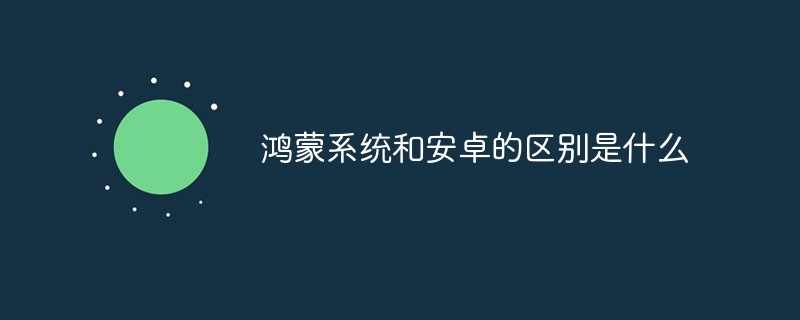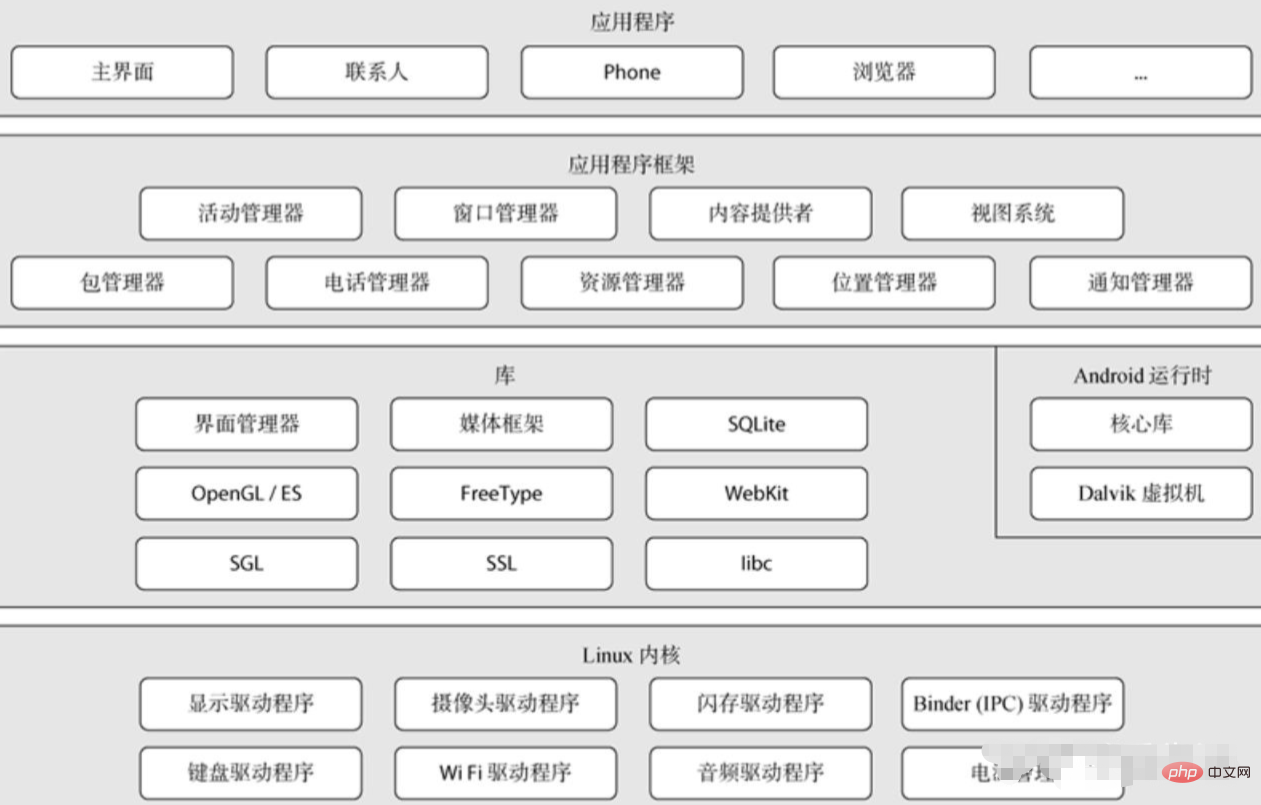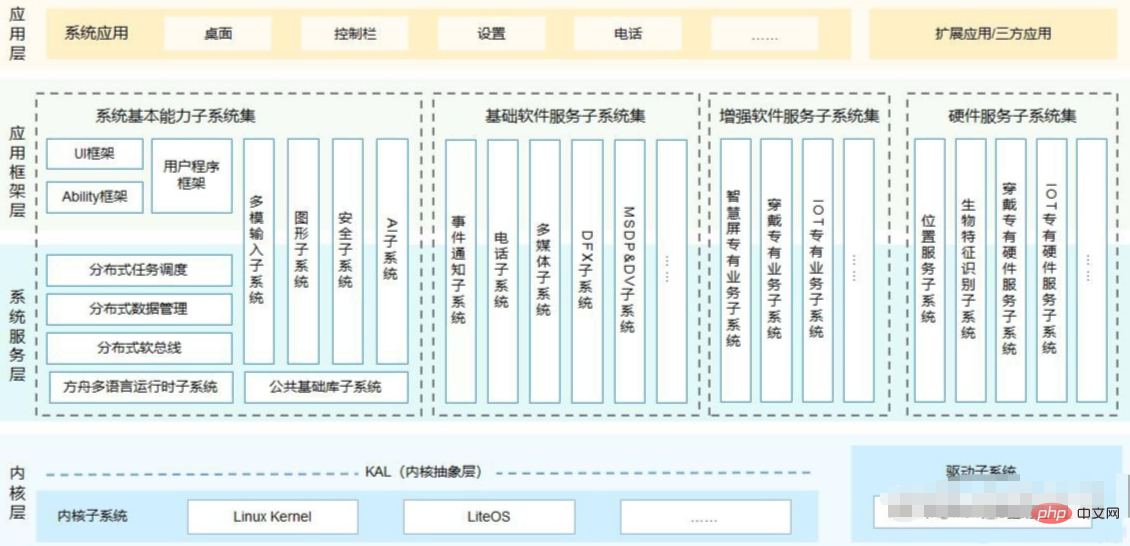What is the difference between Hongmeng system and Android?
Difference: 1. The Android system is based on the macro kernel design of Linux, and the macro kernel contains most of the functions and modules of the operating system. As long as one module fails, the entire system will collapse; Hongmeng operating system is With the microkernel design, problems with modules other than the necessary functional modules of the operating system will not hinder the operation of the entire system. 2. The Android system is suitable for mobile phones, while the Hongmeng system is more compatible with devices and supports multiple devices such as mobile phones, computers, and TVs. 3. The software ecosystem of Android system is very complete, while the ecosystem of Hongmeng system is not as good as Android.

The operating environment of this tutorial: HarmonyOS 2 system, HONOR V30 mobile phone.
What is Hongmeng System
Huawei HarmonyOS (English: huaweiHarmonyOS, HongmengOS). On August 9, 2019, Huawei held the Huawei Developer Conference in Dongguan and officially released the operating system Hongmeng OS.

Hongmeng OS is a "future-oriented" operating system, a microkernel-based operating system for all scenarios (mobile office, sports and health, social communication, media entertainment, etc. ) distributed operating system, which can be expanded on demand to achieve wider system security. It is mainly used in the Internet of Things and is characterized by low latency, even to the millisecond level or even sub-millisecond level. It realizes modular coupling and can be flexibly deployed corresponding to different devices. Hongmeng OS has a three-layer architecture. The first layer is the kernel, the second layer is basic services, and the third layer is the program framework. It is now adapted to smart screens, and in the future it will be adapted to multiple terminal devices such as mobile phones, tablets, computers, smart cars, and wearable devices.
Hongmeng OS On September 10, 2020, Huawei Hongmeng system was upgraded to Huawei Hongmeng system version 2.0. On the 16th of this month, Huawei will hold a beta event for Hongmeng 2.0 system mobile phone developers (the previous article has a detailed introduction, if you want to know more, you can click on the article link below)
Hongmeng system and The difference between the Android system
What is the difference between the Hongmeng system and the Android system? Is it also created based on a virtual machine like Android?
1. Android and Hongmeng mobile operating systems are basically developed based on Linux, but their architectures are different:
The Android system is based on Linux macro Kernel design: The macro kernel contains most of the functions and modules of the operating system, and these functions and modules have the highest permissions. As long as one module fails, the entire system will crash. This is why the Android system is prone to crashes. The advantage is that system development is easy. (Now, Huawei's newly developed Ark compiler is to solve this problem. Any Android software compiled by the compiler can directly communicate with the bottom layer of the system. Hongmeng system plus compiler will replace the virtual machine.) Android uses Java Written in a language that is easy to learn. But it has a disadvantage: it cannot communicate directly with the bottom layer of the system and must be run through a virtual machine. To put it directly, the virtual machine is equivalent to the transmitter: first, the Android application is installed on the virtual machine, and then transferred from the virtual machine to the bottom of the machine. If there is a problem with the virtual machine, the system will be stuck. And the Ark compiler in Hongmeng system is to solve this problem. Any android software compiled by the compiler can directly communicate with the bottom layer of the system. Hongmeng system plus compiler will replace the virtual machine.

Android system architecture diagram
Hongmeng operating system is a microkernel design: the microkernel only includes the necessary functional modules of the operating system (task management, memory allocation, etc.) It has the highest authority in the core position, and other modules do not have the highest authority. That is to say, if there is a problem in other modules, there will be no hindrance to the operation of the entire system. The development of microkernel is very difficult, but the stability of the system is very high. According to some information released by Huawei, we can infer that the Hongmeng system is written in C and C languages, that is, directly using machine language to write apps, canceling the ART virtual machine of the Android system, and directly compiling it into binary machine code. The advantage of this is No transfer is required and the execution speed is fast; however, such an operation also has some disadvantages, that is, it requires a large number of static solutions and requires higher memory space.

Hongmeng system configuration diagram
It is reported that Hongmeng system runs 60% faster than Google’s Android system. Why is it so much faster? There are two reasons:
First; Google's Android system is developed based on Linux, and Huawei's "Hongmeng" system is also developed based on Linux, and a lot of optimizations have been made to Linux. Previously, Huawei launched its self-developed EROFS super file system, which was only compiled based on Huawei Ark. Applications developed with the compiler can improve the performance of the Android system several times. Huawei's Hongmeng system, which integrates EROFS and the Ark compiler at the bottom, is naturally much faster than the Android system.
Second: Android system programmers The APP is written using the JAVA high-level language and packaged into an APK to the Android system. Since the Android system cannot read JAVA high-level language, it must use real-time translation (JAVA virtual machine) to understand (convert into machine language). Because of the additional step of "translation", the smoothness of the Android system has always been inferior to that of Apple's iOS. The Ark compiler, before packaging the APK, uniformly changes the instructions into machine language that the Android system can understand, which means that the "translation" step is omitted, and the efficiency is naturally higher.
2. The scope of use of Hongmeng system and Android system are different:
First: Android system is suitable for mobile phones, while Hongmeng system is more compatible with devices. It supports smart home devices such as smartphones, smart wearable devices, computers, and TVs, forming a seamless and unified operating system that is compatible with all Android applications and adapts to the current 5G and IoT era.
3. After years of development of the Android system, the software ecosystem is very complete. Hongmeng system is not yet ecological.
It is not difficult for Huawei to launch Hongmeng operating system. Compared with launching an operating system, what is more difficult is how to gather developers to continue to develop various high-quality applications for this operating system, so that this operation The system can acquire real value and then develop and grow, forming a virtuous positive cycle between system developers, hardware manufacturers, developers and users. To allow developers to develop applications for the Hongmeng operating system, what is needed is real policy incentives, profit guidance, relying on feelings, etc. cannot be solved and is unsustainable. This is a major problem that Huawei needs to solve after launching the Hongmeng system!
How is the security of Hongmeng system? Can it change the privacy issues of domestic Android software?
Above we talked about the difference between Hongmeng and Android systems and mentioned two concepts: microkernel (Hongmeng) and macro kernel (Android). Hongmeng operating system uses a microkernel, which is naturally root-free, and fine-grained permission control improves system security from the source. The Android system has Root permissions, and users can fully control the Android system after rooting. Hongmeng does not have the Root option. At the same time, according to the official Weibo of Huawei Terminal Company, Hongmeng’s trusted execution environment based on microkernel technology has significantly improved the kernel security level through formal methods and comprehensively improved the security capabilities of terminal equipment in all scenarios. In this regard, Yu Chengdong once said: Microkernel can lock each one individually, and it is impossible for one key to break into all places. The mutual isolation of the outer core is safer and more efficient. Judging from the evaluation of the world's most authoritative security agencies, current operating systems outside can only reach level 2 or 3, while our system can reach levels 5 and 5, the highest level. This is the highest level of security OS. Therefore, the security of Hongmeng system is much higher than that of Android system.
For more related knowledge, please visit the FAQ column!
The above is the detailed content of What is the difference between Hongmeng system and Android?. For more information, please follow other related articles on the PHP Chinese website!

Hot AI Tools

Undresser.AI Undress
AI-powered app for creating realistic nude photos

AI Clothes Remover
Online AI tool for removing clothes from photos.

Undress AI Tool
Undress images for free

Clothoff.io
AI clothes remover

AI Hentai Generator
Generate AI Hentai for free.

Hot Article

Hot Tools

Notepad++7.3.1
Easy-to-use and free code editor

SublimeText3 Chinese version
Chinese version, very easy to use

Zend Studio 13.0.1
Powerful PHP integrated development environment

Dreamweaver CS6
Visual web development tools

SublimeText3 Mac version
God-level code editing software (SublimeText3)

Hot Topics
 1376
1376
 52
52
 Google Android 15 new feature: 'Double-tap with two fingers' to enlarge the screen
May 08, 2024 pm 04:31 PM
Google Android 15 new feature: 'Double-tap with two fingers' to enlarge the screen
May 08, 2024 pm 04:31 PM
According to news on May 8, Google plans to add a new "two-finger double-click" screen gesture to the Android 15 system to enlarge the screen. Google's Android system currently provides 3 ways to zoom in on the screen. The operations are as follows: Screen auxiliary button: The most convenient operation, but it takes up part of the screen and always zooms in the center. The gesture of holding down both volume keys: takes up less screen space, but takes the longest to activate. The gesture of tapping the screen three times quickly: This method also allows you to zoom in on the exact part of the screen you want to zoom in. However, after this gesture is enabled, the Android system will judge based on the user's click interval, which will slow down the device. The fourth method was introduced in the Android 15Beta1.2 update, which is the new "two-finger double-click" screen gesture. It is currently not added in the system settings.
 No more hand-holding, the R corner of the Samsung Galaxy S25 Ultra body is exposed to be close to the Galaxy Note7 mobile phone
Jun 29, 2024 am 02:57 AM
No more hand-holding, the R corner of the Samsung Galaxy S25 Ultra body is exposed to be close to the Galaxy Note7 mobile phone
Jun 29, 2024 am 02:57 AM
According to news on June 28, the source @ibinguniverse tweeted that the Samsung Galaxy S25 Ultra mobile phone will no longer pinch the hands, and the corners will be rounded, making it easier for users to hold it for a long time. Fenye stated in its Weibo content that the body R angle of the Samsung Galaxy S25 Ultra mobile phone can refer to the Galaxy Note7 mobile phone. The attached picture is as follows: The source also said: Galaxy S25 Ultra has a body thickness of 8.4mm, bucking the trend and becoming thinner, making it the thinnest among SUltra models in recent years. S21U to S23U are all 8.9mm, and S24U is 8.6mm. Samsung's design still doesn't want to compromise with the image, and it doesn't want to develop in the direction of a bunch of Oreos. Fenye
 Google Android 15 optimizes storage settings: 'System' broken down into system files and temporary files
May 31, 2024 pm 09:02 PM
Google Android 15 optimizes storage settings: 'System' broken down into system files and temporary files
May 31, 2024 pm 09:02 PM
According to news on May 17, Android engineer Mishaal Rahman recently published a blog post and found that Android 15Beta2 has adjusted the storage settings and subdivided the "System" into system files and temporary files. Note: Android users currently open storage settings and can see the space occupied by different types of files, including applications, documents, pictures, games, audio, etc. There is also a "System" space that displays the storage space occupied by basic system files. In the Android 15 system, in addition to seeing the space occupied by the above file types, System is further subdivided into OS (specific Android version) and system temporary files. Users can see temporary files more intuitively
 'The world's first 7-inch 120Hz high-brush Android handheld console', AYANEO previews Pocket EVO next week
Jul 10, 2024 pm 03:53 PM
'The world's first 7-inch 120Hz high-brush Android handheld console', AYANEO previews Pocket EVO next week
Jul 10, 2024 pm 03:53 PM
Thanks to netizen Wu Yanzu from South China for submitting the clue! According to news on July 6, AYANEO company released on Weibo last night, previewing the launch of a new Pocket EVO product, claiming to be the world's first flagship Android handheld device equipped with a 7-inch 1080 POLED 120Hz high-brush color screen. The main selling point of AYANEOPocketEVO is the use of OLED screens, which provide more delicate colors and faster response speeds, bringing players high-scoring, high-frame-rate gaming and audio-visual entertainment experiences. fenyeAYANEO gaming handheld 60Hz refresh rate: AYANEOMicro: 3.5-inch 960x640 pixels IPSLCD display AYANEOPocketS: 6-inch 1920x1080 or 25
 iQOO 13 preview: battery capacity increased to 6000mAh
Jun 21, 2024 pm 06:12 PM
iQOO 13 preview: battery capacity increased to 6000mAh
Jun 21, 2024 pm 06:12 PM
According to news on June 21, well-known digital blogger Digital Chat Station revealed that the battery capacity of iQOO’s flagship phone iQOO13 this year will be 6000mAh. It is reported that the latest iQOO12 series model has a battery capacity of 5000mAh. Thanks to the development and commercialization of carbon-silicon anode battery technology this year, the iQOO13 to be released in the second half of this year will benefit from the battery technology, and the capacity will directly increase from 5000mAh. To 6000mAh, it is thin and light while taking into account long battery life. In addition, according to the blogger, the iQOO13 series will use the Snapdragon 8Gen4 mobile platform, inherit 3X periscope telephoto, add a single-point ultrasonic under-screen fingerprint, and will also support IP68 dustproof and waterproof, built-in oversized X-axis linear
 Huawei Hongmeng system supports mobile phone models revealed (Huawei Hongmeng system has strong compatibility)
May 05, 2024 pm 12:01 PM
Huawei Hongmeng system supports mobile phone models revealed (Huawei Hongmeng system has strong compatibility)
May 05, 2024 pm 12:01 PM
People are very concerned about the mobile phone models supported by this system, with the release of Huawei Hongmeng system. This article will introduce in detail the mobile phone models supported by Huawei Hongmeng system as well as their features and advantages. 1: Huawei Mate series - the powerful flagship model is naturally one of the first mobile phones to support Hongmeng system. The Huawei Mate series is Huawei's flagship model. For models such as Mate30 or Mate20, you can experience the new functions and optimizations brought by Hongmeng system through system upgrades, whether it is Mate40. 2: Huawei P series - powerful imaging mobile phone Huawei P series has always been sought after by the majority of users for its excellent camera capabilities. Users can enjoy a smoother and smoother operating experience during the photo taking process. The good news is that Huawei P series
 'Tai Chi' Android virtual framework announced that it will be permanently suspended, users need to find new options
May 09, 2024 pm 03:43 PM
'Tai Chi' Android virtual framework announced that it will be permanently suspended, users need to find new options
May 09, 2024 pm 03:43 PM
According to news on May 9, the popular virtual framework application "Tai Chi" on the Android platform came to an end last night. Its official developer announced last night that due to personal reasons, this six-year-old software will permanently stop updating. Since the launch of "Tai Chi", the developers have been going all out to maintain it. The entire process is voluntary and no fees of any kind are charged. However, after becoming a father, he felt that his time and energy were limited and he could not continue to maintain this huge and complex project, so he made the decision to stop updating. Fine-tune and rewrite the given content as follows: According to the editor's understanding, "Tai Chi", as a comprehensive virtual framework application, is characterized by the fact that users can easily use the Xposed module without unlocking, rooting or flashing the phone. Its excellent compatibility
 The iPhone is also getting a 2TB version! It is reported that Apple abandons TLC and uses QLC: lifespan/performance is lower
Jul 25, 2024 am 10:03 AM
The iPhone is also getting a 2TB version! It is reported that Apple abandons TLC and uses QLC: lifespan/performance is lower
Jul 25, 2024 am 10:03 AM
July 25 news: According to foreign media reports, Apple may enable larger storage on the 2026 iPhone, which is expected to be 2TB. The latest revelation from the industry chain is that Apple is accelerating the replacement of QLCNAND, thus raising the upper limit of built-in storage to 2TB. As for why QLC is used, it may be related to Apple's cost control. In fact, there was news before this that Apple may change the storage capacity (enabled on iPhone 16) and no longer use three-layer cell (TLC) NAND flash memory, but use four-layer cells on models with a storage capacity of 1TB or more. (QLC) NAND flash memory. Compared with TLC, the advantage of QLC is that each memory cell can store four bits of data.



